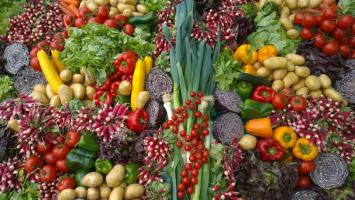
DIET & LIFESTYLE
DISCOVER HOW TO HEAL
Written by John Immel, As if enjoyment and cultural flair weren't enough, spices also have medicinal value that can be used to support your body. Ayurveda has made an art and science of this medicinal value of spices, often using them interchangeably with herbs. With Ayurveda, use of spices literally turns your pantry into a medicine cabinet, once you know how. Effects of SpicesFor starters, note that spices have an especially powerful effect that improves digestion, circulation, metabolism, and immunity. Most spices are antimicrobial as well. Spices have the ability, for example, to improve your ability to digest rich, heavy foods like meat or dairy. Black pepper can help you digest cheese. Hing miraculously prevents beans from causing gas. Cardamom ensures a cup of chai won't lead to mucus congestion. Ginger, ajwain and turmeric are added to most Ayurvedic meals to ensure digestibility. Although the number of calories in your meal stays the same, with spices your ability to process and metabolize these foods change, which may mean that you burn the calories more quickly or find relief from acid reflux. Most spices are some combination of pungent, hot, sharp, light, and dry. These penetrating attributes ignite digestive strength (agni) and burn up toxins (ama). They improve circulation which cleanses your tissues. Often spices have aromatic, acrid, bitter, or sour qualities as well, but not always. The taste (rasa) and sensory experience of each spice gives you certain clues to its medicinal effects. This means you can often tell the medicinal properties of a spice merely by tasting it. Each spice, independant of taste, has unique pharmacological actions as well (prabhav). For example, garlic is mysteriously grounding despite its sharpness. Cayenne, despite its burning effect, is paradoxically anti-inflammatory. Nutmeg is a sedative. And fenugreek, though bitter, is nourishing. The only way to learn these special pharmacological effects of spices is through research and your own experimentation. Does fenugreek nourish you as it does others? Experience will show you. You can use felt sensing to figure out the medicinal effects of the spices you eat. While all spices have some medicinal value, each one is unique. Since spices are so diverse, the sky is the limit of their unique properties and benefits. While many spices have similar properties, there are equally many layers of subtlety to appreciate. Aromatic SpicesHerbs and spices generally fall into several categories. Each has its own pizzazz. Aromatic spices are a class of spices including, unsurprisingly, spices that have a strong aroma. Aromatic spices impart a strong flavor to your meal. Peppermint, thyme, and cinnamon are among the best known aromatic spices. The aroma indicates a high concentration of volatile oils. The strong smell comes from evaporation of these oils. These oils give aromatic spices some surprising health benefits. They are penetrating, subtle, clear, etheric, light, and dry. Many are slightly cool.Common Aromatic Spices
Basil
Aromatic oils shock, refresh and numb tissue, with the end result of relaxing, opening up and clearing stagnant fluids. Aromatic oils relax muscles, especially smooth muscle tissue. This relaxing effect dilates blood vessels, encourages sweating, calms the bronchial tubes and reduces colic. Aromatic spices clear the stomach by relaxing, along with other muscles, the valve at the bottom of the stomach. They improve appetite and hunger (an example is bitter orange peel). They increase gastric juices and kickstart heavy, sluggish digestion after a large meal. Since they aid in protein digestion they are often cooked with meats. Aromatic oils may help reduce acid reflux because they help with digestion, but be cautious. Aromatic spices can also aggravate acid reflux by relaxing the cardiac valve (the valve at the top of the stomach). Aromatic fluids are generally associated with purity and cleanliness. Their dilating effect flushes fluids from sweat and salivary glands, the urinary tract, the breasts (when nursing) and the menses. They are useful to break up fluid stagnation when spring fever in early April leaves the face, hands, and feet feeling swollen. They break up mucus in the respiratory and digestive tract (cardamom). They are used for sore throats. They are ultimately drying and may contribute to drying up breast milk. Their aroma when inhaled easily reaches the brain. Psychologically, aromatic oils inspire, refresh and arouse with a sense of awe and letting go. Sharp SpicesSpices like black pepper, cayenne and mustard seed are often less aromatic than mint or cinnamon. Instead, they are very sharp, hot and irritating. Sharp spices are the most drying and fast acting of spices. You may notice when you eat something with cayenne pepper you immediately start to sweat. The irritation provoked by pungent spices improve circulation as the body responds by thinning the blood, dilating blood vessels and stimulating the heart to beat faster and stronger. With improved circulation the effects of sharp, pungent spices quickly spread to all tissues in the body. Since the immune system acts largely via the blood, good circulation improves immunity. As they move blood, sharp spices also warm up the liver and encourage it to work harder - this is helpful when your liver is stagnant, but can overtax the liver and aggravate Pitta.Common Sharp Spices
Cayenne
Sharp spices warm up the intestines and the digestive fire (agni) speeding up the digestive process in the same way that turning up the heat on your stove cooks your food more quickly. If the fire gets too hot, though, you may get burned. Too many jalapenos and you will feel them on their way out. Pungent spices have a tendency overstimulate Vata. They can overheat those with a hot and sharp Pitta nature, and provoke aggression and irritability. So, Vata and Pitta types should use pungency with caution. Kapha types might find relief and release of mucus congestion as these spices can flush out a runny nose and decongest the lungs in those suffering from excess gooey buildup. As much as they help you digest, absorb, and assimilate food, sharp spices also improve the mind's ability to digest, absorb and assimilate information. You may notice your critical thinking abilities are honed after eating a spicy meal. Emotionally, sharp spices evoke courage and valor in proper balance, but in excess can lead to anger. Your actual meal may also include one or more root spices. The most commonly used root spices are turmeric, ginger, onions and garlic. Root spices are generally less pungent than spices from aerial parts of plants such as seeds and leaves. So, they add a base note that gives the recipe a more grounding feel. Garlic and onion impart a distinct heartiness to recipes. Choosing the Right SpicesCooking with spices for medicinal effect can seem unfamiliar and daunting to the novitiate. Too much black pepper for the wrong person and they'll feel like their mouth is on fire! Not enough digestives in a rich meal and your guest will feel tired after eating. In general, heavier, more sluggish Kapha types can handle more heat and stimulation from spices. Nearly all spices are considered to be beneficial for Kapha types. Lighter Vata types do well with a moderate amount of spice - especially digestives like ginger, black pepper and cumin. Pitta does best with small amounts of cooling spices like cardamom, cloves, coriander, fennel and cilantro.Start with 2 or 3 spices you like, while slowly learning their medicinal effects. Since it can take some time to learn about a new spice, we recommend cooking with a spice every day for a week to master it. Look up a few recipes using the spice to inspire your creativity. Try tasting a bit of the spice on your tongue. Try a dish at a restaurant that uses the spice, to see how the pros do it. Finally, look up the spice in an herb book to learn about its medicinal properties. Consider our spice mixes to be your training wheels. If you need ideas, a personal recipe book from Joyful Belly can get you off to a great start. As you become more practiced, allow your nose to guide your creative impulse. Soon, you'll be a maestro of flavor. Churnas & Spice BlendsIn cooking, spices generally appear in familiar blends and combinations. From Garam Masala in India, to Za'atar in the Middle East, to ginger, soy, garlic and scallion in China, family kitchens around the world employ familiar tastes to impart a traditional and homey feel to their favorite meals. Some popular spice combinations in western cuisine include Pumpkin Pie Spice, Old Bay, and Herbes de Provence.Ayurvedic chefs also use familiar spice combinations for medicinal effect. These specific combinations of powdered herbs are called churnas, which literally means powder in sanskrit, the ancient language of Ayurveda. Check out the Hingvastak Churna for Vata, Avipattikar Churna for Pitta, and Trikatu Churna for Kapha. CCF is Ayurveda's famous spice combination for cleansing and detoxification. To create your own combinations, start off with 1-2 aromatic spices and 1 pungent spice. Mix them together and store them in a small jar, containing a week's worth at most to keep them fresh. You'll find this simple technique gives rise to many exciting possibilities. Besides just enhancing the flavor of your food, churnas give your unique body the support it needs to avoid unwanted side effects like gas, bloating, heartburn and sleepiness after eating. Churnas are especially helpful when traveling or eating out, when you're not in control of what you'll be served. In these situations you can simply sprinkle your medicinal digestive churna on your food, much like salt and pepper. Cooking with SpicesNow that you've chosen which spices you'll use, it's time to learn the art of cooking with them. For maximum flavor, always buy whole seed and grind fresh before using. Freshly ground spices have more flavor and prana (vital life force). Once a seed is ground, it dies and the aroma as well as the medicinal qualities evaporate quickly.You can maximize the fresh taste of spices by infusing them into water and oil. Some flavors in spices are water soluble. Others are fat soluble. To harvest all the flavor, make a paste by mixing spices with a small quantity of water. Allow five minutes for the spices to absorb the water. Then, fry them in oil. The action of boiling the absorbed water out of the spices pushes the flavor out into the oil. A spice infused oil spreads throughout the recipe and increases absorption of flavors into the ingredients. Once dissolved in the oil, the aromatic spice doesn't evaporate as quickly either. If you are simmering food for a long time, such as in a crock pot, add the aromatic spices 15 minutes before removal from the heat. Otherwise, the aromatic oils will slowly evaporate, and the flavor with it, from your simmering concoction. If cooking spices with onions, add the spices as the onion begins to brown. Onions are mostly water. The water in the onions prevents the temperature in the pan from rising above the boiling point of water. Onions progress from opaque to translucent, then slices get desiccated and thin. As the water in the onions boils off, the temperature begins to the rise and the onions start to brown. Then, add the spices, sauteing an additional 15-30 seconds. Finally, spices are usually mixed into a broth or sauce. Broths and sauces are themselves also integral to the flavor in a dish. Sauces and broths are generally a combination of water, sweet, sour, and salty tastes. The source of sweetness can come from dried fruits, sweet root vegetables such as carrots, or even jaggery (unrefined sugar). Use lemons, limes or vinegar for sourness. Use salt, soy sauce, or seaweed to impart salty taste. Finally, garnish the recipe with fresh herbs. Cilantro is our favorite. It's cooling, detoxifying and a digestive - a rare combination - making it the perfect fresh accent for just about any dish. ConclusionWith a vibrant combination of spices, a delicious sauce or broth, and a crunchy garnish of fresh herbs, your meals will work magic and bring both delight and medicinal value to your life. In Ayurveda, your spice cabinet can double as your medicine cabinet. Harness the power of herbs and spices to create the digestive benefits you want. Enjoy your new creativity! With spices, your meals will be unique each time you make them. Whether oatmeal, kitchari, or your favorite weekend dish, spice combinations help make sure you stay healthy and balanced, while improving the flavor.Note: Be sure to check with your doctor before making any changes to your health and wellness plan. READ MORE ON THIS TOPIC
BROWSE SIMILAR ARTICLES BY TOPIC

About the Author John Immel, the founder of Joyful Belly, teaches people how to have a healthy diet and lifestyle with Ayurveda biocharacteristics. His approach to Ayurveda is clinical, yet exudes an ease which many find enjoyable and insightful. John also directs Joyful Belly's School of Ayurveda, offering professional clinical training in Ayurveda for over 15 years.John's interest in Ayurveda and specialization in digestive tract pathology was inspired by a complex digestive disorder acquired from years of international travel, as well as public service work in South Asia. John's commitment to the detailed study of digestive disorders reflects his zeal to get down to the roots of the problem. His hope and belief in the capacity of each & every client to improve their quality of life is nothing short of a personal passion. John's creativity in the kitchen and delight in cooking for others comes from his family oriented upbringing. In addition to his certification in Ayurveda, John holds a bachelor's degree in mathematics from Harvard University. John enjoys sharing Ayurveda within the context of his Catholic roots, and finds Ayurveda gives him an opportunity to participate in the healing mission of the Church. Jesus expressed God's love by feeding and healing the sick. That kindness is the fundamental ministry of Ayurveda as well. Outside of work, John enjoys spending time with his wife and 7 kids, and pursuing his love of theology, philosophy, and language. STUDY AYURVEDA
Questions, Comments & Impressions of 'how to cook with spices for medicine'?Is there something else you'd like to know about 'how to cook with spices for medicine'?109 likes      Sign in to review this article Sign in to review this article
|
Join Joyful Belly.
Want our top Ayurvedic recipes and health tips?Subscribe to our free newsletter!

 SAVE ARTICLE
SAVE ARTICLE

 On MeWe
On MeWe On Pinterest
On Pinterest On Facebook
On Facebook On Twitter
On Twitter On WhatsApp
On WhatsApp On Email
On Email My Saved Articles
My Saved Articles


